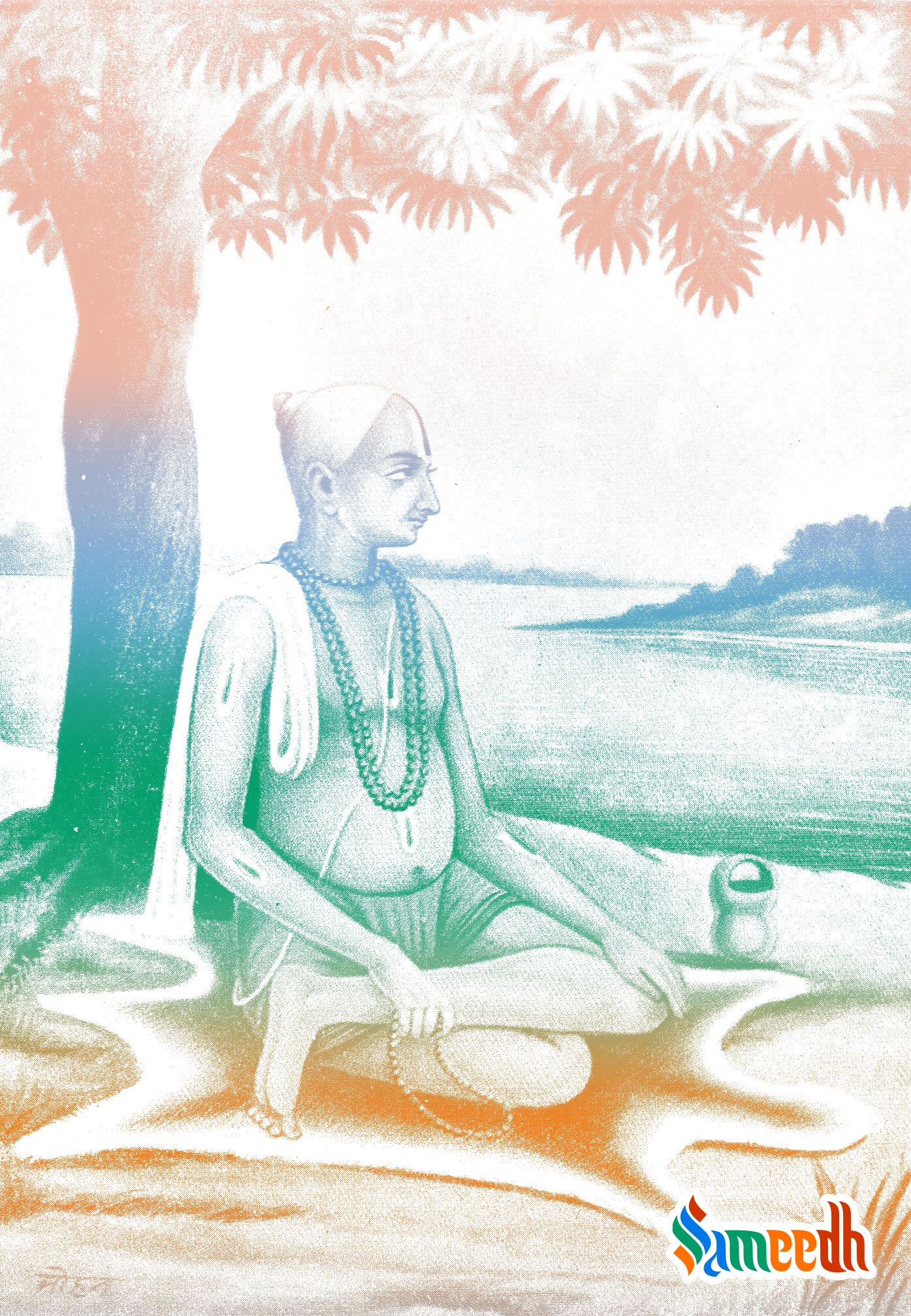Goswami Tulsidas, born as Ram Bola Dubey (1532-1623), is one of the most revered saints and poets in Hinduism. He is best known for his epic poem “Ramcharitmanas,” which is a retelling of the Sanskrit epic Ramayan in Awadhi, a dialect of Hindi. His work has made the stories of Lord Ram accessible to the common people, significantly influencing Hindu culture and devotional practice.

Image Source: Mohan
EARLY LIFE
A boy who uttered Ram at birth
Tulsidas was born in Rajapur, a village in present-day Uttar Pradesh, India as Rambola Dubey. According to legends, he was born on the seventh day of the bright half of the lunar month Shraavana (July-August). His childhood was spent in the cities of Ayodhya and Varanasi. He grew up at the banks of river Ganga, which gave him the perfect atmosphere and scenery to compose and grow as a writer.
According to mythology records, he was in the womb of his mother for twelve months and came out saying Ram instead of crying, as babies usually do. This is the reason why he was named Rambola, at birth. He was abandoned by his parents at an early age and grew up as an orphan living on the alms he collected from people. According to some records, it is said that Goddess Parvati took the role of feeding him every day as a brahmin woman.
LIFE EVENTS AND CONTRIBUTION TO SOCIETY
Major Works
- Ramcharitmanas: Tulsidas wrote one of the most famous and revered versions of the epic Ramayan and it contained around 12,800 lines. Written in Awadhi, this work is a devotional epic that retells the story of Ram, making the sacred text accessible to the common man. It is divided into seven books, each narrating different parts of Ram’s life. The “Ramcharitmanas” is considered a masterpiece of devotional literature and is highly revered in the Hindi-speaking world. It is also known as, ‘Tulsikrit Ramayan’ and is known as ‘the living sum of the Indian Culture’. This version of Ramayan became very popular due to the beautiful understanding and explanation given by Tulsidas through detailed Chaupais and Dohas. The beauty of this literature has been celebrated across several sections of the population from religious devotees to historians who studied the subject.
- Hanuman Chalisa: Another popular work, this is a 40-verse hymn dedicated to Lord Hanuman. It is recited by millions for protection, strength, and devotion.
- Other Works: Tulsidas wrote many other devotional hymns, including “Vinaya Patrika” and “Kavitavali,” which express his deep devotion to Ram.
Philosophy and Impact
- Bhakti Movement: Tulsidas was a prominent figure in the Bhakti movement, which emphasized devotion to a personal god and the importance of a loving relationship with the deity. His works encouraged the devotion to Lord Ram as an accessible and loving god.
- Accessibility: By writing in the vernacular language, Tulsidas made the stories and teachings of the Ramayan accessible to the masses, breaking the monopoly of Sanskrit, which was understood by only a few scholars.
- Cultural Influence: His works have had a profound influence on Indian culture, music, theater, and literature. The “Ramcharitmanas” is still recited and performed in various forms across India, particularly during the festival of Ram Navami and Ramlila (the dramatic reenactment of the life of Rama).
LIFE AFTER MAJOR EVENTS
The Composer of Hanuman Bahuk
During the late 17th CE, Tulsidas started suffering from several ailments and pain. During this time he wrote one of his famous compositions based on all the pain he is suffering. It is called Hanuman Bahuk. He wrote his last work, Vinaypatrika which was based on his worship and prayers to Lord Ram to help him with the problems he was facing due to his life in Kalyug.
LIFE LESSONS
His Sighting of Lord Ram and Hanuman
It is recorded in different accounts of several other poets and authors that Tulsidas had the privilege of witnessing the sight of Lord Ram and Hanuman with a boon he was granted. He witnessed the sight of Hanuman close to a place in Varanasi and he blessed him with a boon of the sight of Lord Ram.
One day, Tulsidas witnessed Lord Ram when a young boy came to him to get a tilak of sandalwood that Tulsidas was making. He gave Tulsidas the sight he had been yearning for a long time.
Tulsidas mentions this incident in his work, Vinaypartika where he mentions the sighting and meeting at Chitrakoot.
LITERATURE PUBLISHED
Composer of Legendary Indian Literature
Tulsidas came to be known as a well-known composer of the literary works which have been revered by all the generations. He was blessed and ordered by Lord Shiv to write poems and compositions in Ayodhya and write in Awadhi language. Aside from the various books and poems he wrote, Tulsidas is known for giving great advice and lessons through his Dohas. His compositions and lessons have travelled centuries and different eras to reach our lives.
MOTIVATING LITERATURE
The works of Tulsidas continue to inspire literature today. The literary works of Tulsidas are the work of legendary literature which continue to inspire the literature and media of today.
Goswami Tulsidas’s legacy endures through his literary contributions and the widespread devotional practices he inspired. His works continue to be a source of spiritual guidance, cultural identity, and artistic inspiration for millions of Hindus around the world.
To know more about such legendary figures in the Indian Mythology, keep reading blog posts on Sameedh.
